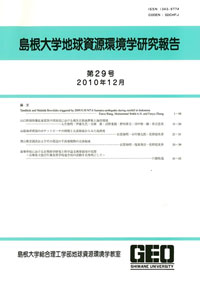島根大学総合理工学部地球資源環境学教室
ISSN:1343-9774

number of downloads : ?
Use this link to cite this item : https://ir.lib.shimane-u.ac.jp/7320
Geoscience reports of Shimane University 27
2008-12-25 発行
隠岐島後,末期中新世葛尾層火道角礫岩と粗面岩岩片中のアルカリ長石K-Ar 年代
Geology and petrography of vent breccias of the Latest Miocene Tsuzurao Formation, and alkali feldspar K-Ar age from a trachyte essential fragment, Oki-Dogo Island, SW Japan
Sawada, Yoshihiro
Tome, Akane
Kitagawa, Hiroya
Kobayashi, Shinji
Imaoka, Teruyoshi
Itaya, Tetsumaru
File
Description
The Tsuzurao Formation is distributed in the northeastern part of Oki-Dogo Island in an area about 4.5 km E-W by 6 km N-S. It unconformably covers the Oki metamorphic rocks and the Tokibariyama Formation(Figs. 1 and 2). The Tsuzurao Formation consists mainly of rhyolitic pyroclastic flow deposits, with a small volume of rhyolitic air fall deposits and associated rhyolite lavas, dikes, and trachyte essential fragments and xenoliths. Vent breccias and feeder dikes are distributed in the eastern and southwestern parts of the Tsuzurao Formation(Figs. 2 and 3). Vent breccias are intruded into the basement as a fissure vent 1500 m long and 400 m wide. The vent breccias are massive, and are composed of rhyolite and trachyte essential fragments and accidental fragments derived from the basement. The vent breccia matrix consists of rhyolitic pyroclastic material. Many trachyte fragments are elongated, and some are enclosed by rhyolite fragments or are mixed with them. Trachyte fragments consist of alkali feldspar, fayalite, hedenbergite, alkali amphiboles(arfvedsonite, riebeckite), magnetite, and apatite. Rhyolite is composed of alkali feldspar, quartz, alkali amphiboles(arfvedsonite, riebeckite), annite, magnetite, apatite. The alkali feldspars in rhyolite are albite(An1.8-1.7 Ab90.4-93.0 Or7.8-5.3)and anorthoclase - sanidine(An0.0-2.0 Ab34.6-58.2 Or41.8-86.0). In trachyte they are anorthoclase - sanidine(An3.8-6.4 Ab36.0-50.9 Or41.5-52.0 and An0.0 Ab46.8 Or53.2).
Alkali feldspar from a trachyte essential fragment in the vent breccia yields a K-Ar age of 5.45±0.17 Ma. This is similar to the radiometric ages of the Omosu Formation and Hei Trachyte Group in Oki-Dogo Island.
Alkali feldspar from a trachyte essential fragment in the vent breccia yields a K-Ar age of 5.45±0.17 Ma. This is similar to the radiometric ages of the Omosu Formation and Hei Trachyte Group in Oki-Dogo Island.
Other Article
